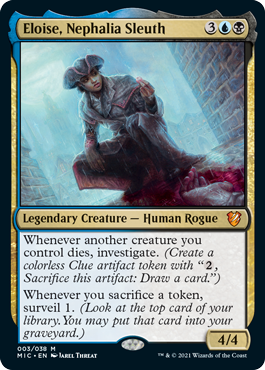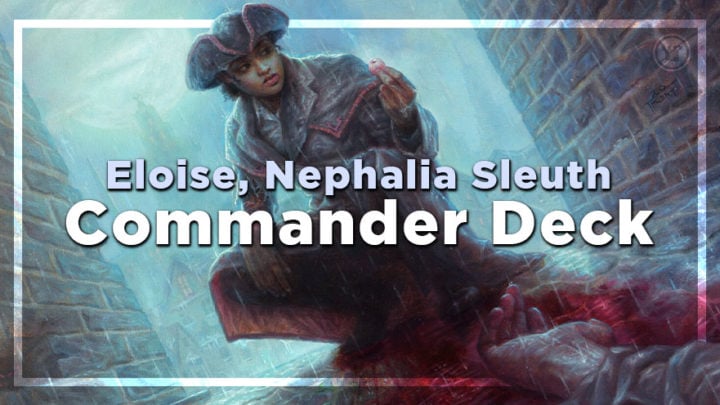Brewing means very different things to different people. For some, it’s a means to an end; a necessary step between the player and the games they want to play. For others, it’s the journey from idea to final draft that forms the deck’s personality.
While there’s no right or wrong way to view it, most Magic players respect those that brew. Many players want to learn how to brew, and those that already brew regularly strive to hone their skills. Some just want to find the inspiration for a new deck. That’s why I’m starting this new series of articles: Anatomy of a Commander Deck.
The goal of this series is to lay bare my brewing process, so that you might pick up something new from it. I’ll talk about how I break down a deck and how I search for relevant and synergistic cards. My hope is that this will spark some inspiration in you and accelerate your own journey to becoming a master deck brewer!
As a general rule, I’ll be aiming to keep the final deck price around $100. It’s a fairly reasonable budget for most players, and it’s usually the sweet spot between power and affordability.
So without further ado, let’s brew!
Our Commander: Eloise, Nephalia Sleuth

This week’s commander is the second-in-command of the new Undead Unleashed preconstructed deck. Eloise’s unique abilities make her a flexible commander that can be taken in a number of different directions.
The first thing that stands out to me is that she wants tokens — whether she’s making them herself or sacrificing existing ones. There’s also a fascinating link between her two abilities: if the tokens you make are creatures, you’ll trigger both abilities when you sacrifice them. This could lead to a powerful Aristocrats build, though it’s a fairly obvious choice.
I tend to follow the road less traveled when it comes to brewing, which is why I’m drawn to the investigate mechanic. Clues are artifact tokens, and there are a lot of powerful artifact synergies you can take advantage of. The first card that came to mind was Academy Manufactor, which gives you a Food, a Clue, and a Treasure for each one of those tokens that you generate. This is the kind of effect that can make these lower-impact abilities more potent, and it’s the perfect starting point for building this deck.
Section Breakdown
When I brew decks, I follow a simple checklist to ensure I have all bases covered. It’s also great to help keep things on track, preventing me from going wild. There’s nothing more difficult than being left with 120+ cards and struggling to make cuts!
Here’s the basic template I follow:
- 47-50 mana sources (see my article on budget mana bases)
- 5-10 removal spells (including counters and graveyard hate)
- 5-8 tricks (including protection)
- 5-10 value cards (card advantage, recursion)
- 1-5 win conditions
If you take the maximum count for each section, you’ll have 16 slots for other cards that fit your game plan. This may sound low at first, but if you ensure that all your cards synergize with your main game plan, your deck will feel greater than the sum of its parts.
I’ve covered the basics of searching for the right cards in my “How to Brew on a Budget” article, but it mostly involves EDHREC and Scryfall. For a deck like this, I’ll generally search for cards with the words “token,” “creature,” “sacrifice,” or “artifact.” To help break these down further, I’ll narrow the search to only creatures at first, followed by instants, then sorceries, etc.
Lands & Ramp
You can’t cast your spells without mana. I always start building my deck with the mana base, which includes both lands and mana acceleration. Carving this out first means that the basic function of the deck is covered and doesn’t need to be squeezed in later.
There’s plenty of reasonable fixing in Commander, right down to the most budget levels. Darkwater Catacombs, Tainted Isle, and Sunken Hollow are all dual lands with very little drawback, particularly if you run a reasonable number of basic lands.
Burnished Hart and Solemn Simulacrum are excellent staples that will fit in beautifully with Eloise. They’re creatures that are happy to be sacrificed, which will trigger Eloise, and they’re artifacts, which will further bolster the theme.
As you want to make a lot of artifact tokens, Inspiring Statuary will be a great addition to the deck. It’ll let you power out big spells ahead of the curve, and cast multiple spells in a row if needed. This works particularly well with Blinkmoth Urn: you can take advantage of the Urn’s ability, then tap it to improvise a spell, turning it off for everyone else!
Removal
Every deck needs a way to interact, and it often comes in the form of removal. My definition of “removal” here is quite broad, as it includes elements like counterspells and graveyard hate. For this deck, removal that either generates a token or causes one of your own creatures to die is ideal.
Resculpt is a particular favorite of mine, and it’s one of the best blue removal spells in Commander. Not only can it permanently deal with a wide range of problems by itself, but when you pair it with Liquimetal Torque, you can exile enchantments or planeswalkers, too! Amphin Mutineer is another great removal piece, and it’s one that Eloise will happily surveil into the graveyard for value. It’s these little synergies that really pull a deck together.
Evoke creatures work well with Eloise, too: they sacrifice themselves immediately, giving you another Clue token. Night Incarnate and Shriekmaw are two classics that will do great work in this deck, and you can always cast them for additional pressure, if needed!
Spell Swindle is probably the best counter for this deck, as the number of tokens this can net you is truly absurd. You’ll even be happy to counter a spell that costs less than Spell Swindle; the entire deck makes great use of Treasures, so any extras you can pick up while playing the game will go to great use. There aren’t many other counters that care about artifacts in an impactful way, but Negate and Arcane Denial are a good power level and are worth the slots.
Value & Recursion
This is the section that tends to vary the most. Every deck needs card advantage to keep you from running out of gas, but some commanders facilitate this perfectly well by themselves. If you have access to a value engine in the command zone, you won’t need to dedicate as many slots. Eloise does provide reasonable value, but when compared to known value commanders like Tatyova, Benthic Druid, she falls a bit short.
Single-use value pieces are great to help you dig a little deeper to keep your momentum going in the early game. Deadly Dispute is the perfect card for this: it sacrifices an artifact or creature to trigger Eloise, it draws two cards for very cheap, and it gives you a token you can sacrifice. Other cheap value pieces that fit well here are Thoughtcast, Reverse Engineer, and Thought Monitor; they often cost just one or two mana, leaving you with most of your mana available to push your game plan forward.
Repeatable value pieces will ensure that you don’t run out of steam in the mid-to-late game. They often need protecting, but they’re well worth the investment. Shimmer Dragon can actually protect itself, and draw you upwards of five cards per turn once you’re up and running! Sai, Master Thopterist is another option; he’s a bit different in that he rewards you with tokens, but he’s also a powerful sacrifice outlet.
Recursion is an important element of any Commander deck, and it’s often overlooked. Most decks should be running some form of graveyard value, and this one is no exception. (See my article on utilizing the graveyard for a full run-down on this!) Emry, Lurker of the Loch is the perfect recursion piece for a blue artifact deck; she often costs just one mana, and you can rebuy several cards if she’s left unchecked. Trading Post is another option; though less effective than Emry, its utility warrants inclusion. The mana base can even squeeze in a Buried Ruin for an extra little bit of value, too. Now there’s several ways to keep the artifacts coming back!
Tricks
In my opinion, every deck needs tricks. They catch people by surprise, protect important threats at the right time, or just add a little chaos to games.
Lazotep Plating is criminally underplayed in Commander. It works extremely well here; it gives you a token that you can later sacrifice, and does blue’s best Heroic Intervention impression. It’s ideal for protecting Eloise and Academy Manufactor, or even for throwing out a surprise blocker in a pinch! Swiftfoot Boots and Malakir Rebirth are more popular options that will serve you well, too.
Every blue deck should contain a clone effect of some sort, even if just to mix things up. I was considering Phyrexian Metamorph for this deck because it’s an artifact, but Vizier of Many Faces may be better fit. You can use it twice thanks to embalm, or let Eloise surveil it into the graveyard. Once you embalm it, it becomes a token, which will trigger Eloise again when it dies. Cackling Counterpart is another option that you don’t mind putting into the graveyard, and you can use it at instant speed for even more shenanigans.
Fog effects come in many forms in Commander, and I find the most interesting ones are those that do more than just prevent damage. Illusionist’s Gambit punishes other players for attacking you, and it can cause severe blowouts. On a similar note, Masterful Replication can turn seemingly normal situations into disasters for your opponents. Here’s a simple example: If your opponent tries to wipe the board, turn all of your Clues into copies of Solemn Simulacrum to draw a pile of cards. You can make some really absurd plays with it: why not turn all of your Clues into Academy Manufactor copies? (Fair warning: You may have to pause the game to calculate how many tokens you make when you investigate.)
Win Conditions
While you can win through regular combat damage, you’ll often need something more impactful to finish off your opponents. Dedicated win conditions fulfil that role, but can often provide some extra value while you set up for the kill.
Nettlecyst and Cranial Plating are ideal win conditions for artifact decks that have incidental creatures, so they’ll work great here. Strapping one of these to one of Sai’s Thopter tokens can often be enough to finish off an opponent; even suiting up Eloise can easily one-shot an unsuspecting opponent!
If you can’t close the game out through combat, Marionette Master can easily gun your opponents down in no time. Her significantly smaller son, Disciple of the Vault, is another great option; not only can he whittle away at life totals, but he triggers on your opponents’ artifacts, too. This makes him extremely dangerous for other artifact decks, and punishes Dockside Extortionists!
Sometimes, you need just a little bit more time or resources to close out the game. Time Sieve can give you the time, provided you can supply the artifacts; most of the time, you’ll get at least one full turn, thanks to any extra tokens lying around. If it’s resources you’re after, then The Antiquities War is ideal. It’ll help you dig for more artifacts, and if your opponents don’t deal with it, they’ll probably lose on the spot. Rise and Shine is a similar effect, and it’s another great way to convert your random artifacts into a win.
Main Game Plan
This is where the fun really begins! The remaining slots in the deck are free to be used in whatever way you see fit. The cards and synergies in this section are central to your deck’s unique identity; make sure it speaks to you in a way that will make you look forward to playing it.
I’ve opted for a very grindy game plan; it’s all about the incidental value gained from investigating, so Junk Winder feels like a great option. It can come down for as little as two blue mana and make sure opponents don’t pull too far ahead. It’s also excellent at shutting down Voltron decks by tapping their main attacker. Araumi of the Dead Tide is another great way to generate more tokens and eke out value, especially when Eloise is stocking your graveyard with cards. Giving Marionette Master encore is a great way to close a game instantly, but you can also just bring back a Thought Monitor!
Sacrifice outlets are necessary to make sure this engine keeps turning. Keskit, the Flesh Sculptor is a brilliant use for the extra tokens or creatures you’ll have lying around. Fain, the Broker is another sacrifice outlet, much like Trading Post: a jack-of-all-trades that plays a role at different points in the game. God-Eternal Bontu is a ridiculous one-shot way to convert permanents into cards in hand; it’s ideal if you sense a board wipe coming.
With all of these sacrifices, Eloise should be surveilling quite a bit. Even though the deck is focused on the artifact tokens, you can still make great use of her extra ability. Disinformation Campaign is a repeatable value piece that can restrict opponents while keeping you flush with cards. Dimir Spybug is a set-and-forget threat that can get out of hand over the course of a couple of turns; Darkblade Agent does a great Oakhame Adversary impression. Enhanced Surveillance lets you dig even deeper with surveil, and you can exile it to avoid decking yourself or folding to graveyard hate!
The Finished Deck

The final list comes in at around $110, and feels like a very solid deck. This could easily contend with upgraded preconstructed decks, and can it hold its own against higher power level builds.
Even though this article is about the process of the brew itself, I can’t leave you without some options for upgrades! If you have the budget for it, you could look at adding some of the pricier sacrifice pieces, like Grinding Station or Skullclamp. They’re quite expensive, but they add a sizable bump of power to the deck.
All brews require testing and tweaking to get them to a settled or tuned state. This is where personal preference really comes into play; only you will know how you want the deck to feel, and what direction to take it from here. If you have any ideas to add, or if you’d take the deck in a different direction, I’d love to hear your thoughts! Let me know over on Twitter if I’ve helped make the brewing process any easier, or inspired a brew of your own!

Scott is an Irish content creator and the Head of Budget Magic for the Izzet League. He focuses on affordable decks in Pioneer, Modern, and Pauper, particularly ones that stray from the mainstream. When he’s not writing about his favorite decks, he can be found talking incessantly about them on Twitter and on The Budget Magic Cast.

